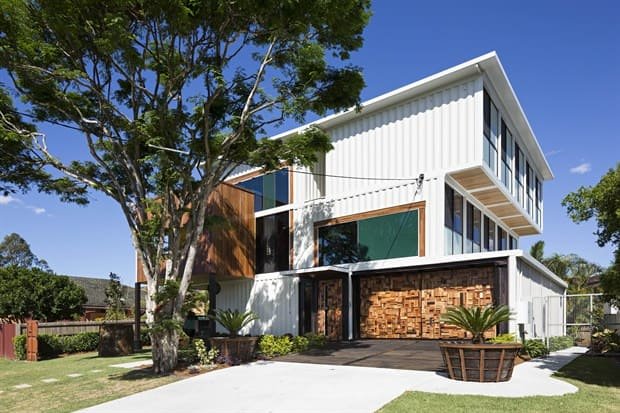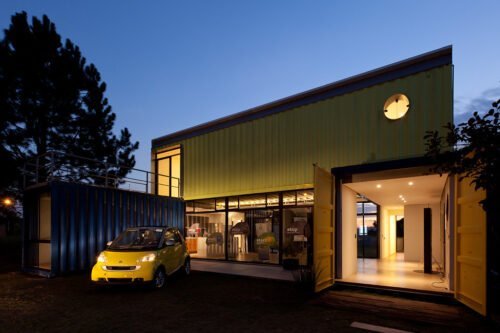Many people come to our site and see shipping container homes and fall in love with how incredible and affordable they are, but they always want to know if it is safe to live in a container home. We receive emails from mothers asking if a container home is safe for their families to live in.
We also receive emails from people who want to build a container home to use in nature and want to know if it is safe from people entering them. So today, let’s take a look at exactly how safe containers are and whether you should consider living in a container home.
Do containers have harmful chemicals?
The most common safety question people ask is whether containers have harmful chemicals. I think many of these concerns come from a well-written article about the advantages and disadvantages of living in a container home.
The article highlights two key concerns:
- The wooden floors used in most containers are treated with dangerous chemicals, such as pesticides.
- Some containers are coated with paint that contains harmful chemicals like phosphorus and chromate.
But, like most things, there is more to this than meets the eye. If you are buying and building your home with new containers and are ‘buying them directly’ from Asia, then you don’t have to worry about these issues.
You can simply specify to the manufacturer not to treat the floors and not to coat the containers with hazardous paint. However, using new containers to build your home increases the cost.
Now we have to talk about used containers. By building with used containers, you are helping to recycle and thus contribute to reducing the carbon footprint. By recycling, you prevent these materials from becoming waste and transform them into completely new homes, extending the life of the shipping container.

But if you purchase your containers second-hand, it is highly likely that the concerns are true for your containers. They have probably been treated with these harmful chemicals. What can be done about it?
First, you can reach out to the original manufacturer of the container and inquire if the floors have been treated with hazardous chemicals. To do this, use the unique identification number of the containers to trace who manufactured the container. For more information on that, read the article “How to Buy Containers” here.
If the floor has been treated with hazardous chemicals, what can you do? We spoke to Larry from Sea Container Cabin, who converted his used containers in 2010. To protect himself from the chemicals sprayed on the wooden floor, he used a non-breathable floor covering.
This underlayment was placed directly over the original wood floor. Tiles were then placed on top of the underlayment. If you want to be completely safe, you can even remove the original wood floor and replace it with marine plywood from your local hardware store.
There may be toxic paint coatings used on second-hand containers. This coating is to protect the container from saltwater while in transit across the ocean. It is vital for containers when used for cargo transportation, but obviously not great when we use these containers for building homes.
Typically, the danger is not from off-gassing but from physical contact with the paint. The first thing you should do is contact the manufacturer of your container and find out exactly what paint has been used. If your containers have been coated with harmful chemicals, it is generally best to remove the coating or encapsulate it with something else. Spray foam insulation or non-toxic paint are usually suitable for this purpose.
Are container homes hurricane-proof?

We have received emails from several people living in critical points of natural disasters, asking if container homes can withstand hurricanes. These questions are undoubtedly inspired by the photos we have seen from Hurricane Katrina.
In the photos, wooden houses are shown completely devastated by Katrina, while sitting on top of the wreckage are fully intact shipping containers. Containers are designed to be stacked when fully loaded with over 26 tons of cargo in each container. It’s no wonder these containers withstood Katrina.
Currently, we have no knowledge of any container home that has experienced a hurricane, but we certainly know that shipping containers can withstand hurricanes. We have already discussed Todd Miller’s maritime container home in our Graceville Container House case study. For those who don’t know, he decided to build a container home using 31 containers!
The house was placed on nine-meter deep micropile foundations, which were covered with concrete piers, and the containers were anchored onto these concrete piers. While it is difficult to say that any structure is completely hurricane-proof, as we never know the extent of future “super storms,” this house is highly hurricane-resistant due to the foundations and anchors used.
What is also interesting about this example is that he built his house in known floodplains in Queensland. The local planning authority approved the house to be built in this area because, according to Todd’s plans, it demonstrated that living in a container home is safe and that the house was flood-proof.

Is it safe to live in a container home?
We have received this question a surprising number of times. Often, prospective homeowners plan to use them as a cabin in the wilderness. Therefore, they want to be able to leave their container home for months without worrying if someone has broken into it. To answer this question, consider what a container was originally built for.
Containers are designed to be an impenetrable and airtight storage solution used for transporting goods worldwide. In fact, when containers were first used in the 1950s, the amount of lost or stolen cargo significantly decreased, as we discussed in The Complete History of Shipping Containers.
Before containers, goods were loaded onto ships as bulk cargo. This essentially means that the goods were in sacks, boxes, or barrels. It was known that some workers would steal these goods, and it was considered a cost of doing business at the time.
However, when containers came into the scene, the number of stolen products decreased dramatically. This was because the owner could lock the containers before loading them onto the ship. Containers are one of the most secure storage facilities you will find. However, when people convert the container into a home, they often cut the metal and modify the container’s structure, which reduces its security.
But a container converted into a home is as safe as a traditionally constructed house. If you want your container to be even more secure because you plan to use it in a remote location, you should leave the original structure of the container intact. To do this, you will need to install windows and doors in the original container doors.
This way, when you convert your container into a home, you can also lock the original container door to seal your container. When you stay in your home, you can leave the doors of the original container open to let in light, but you will still have the remodeled windows and door closed, just like in a regular house.
Now that you know if it is safe to live in a container home, let us know how you make your container secure in the comments section below.

«Tu casa con contenedores» es la única guía paso a paso que existe para construir tu propia casa con containers desde cero. No importa si no tienes conocimientos sobre construcción, si pensar en ello te da dolor de cabeza, si eres constructor o trabajas en una oficina. La guía está escrita para que cualquiera pueda entenderlo. MAS INFORMACIÓN CLIC AQUÍ Construye Tu Casa con Contenedores Paso a PasoHágalo Usted Mismo




